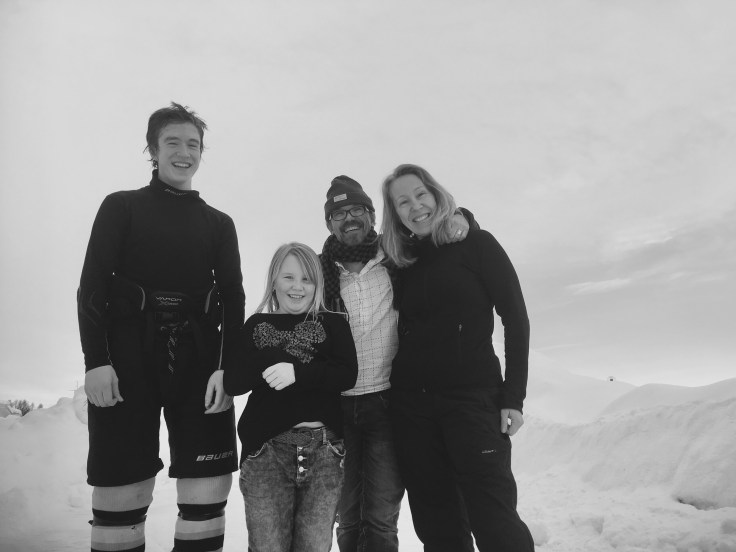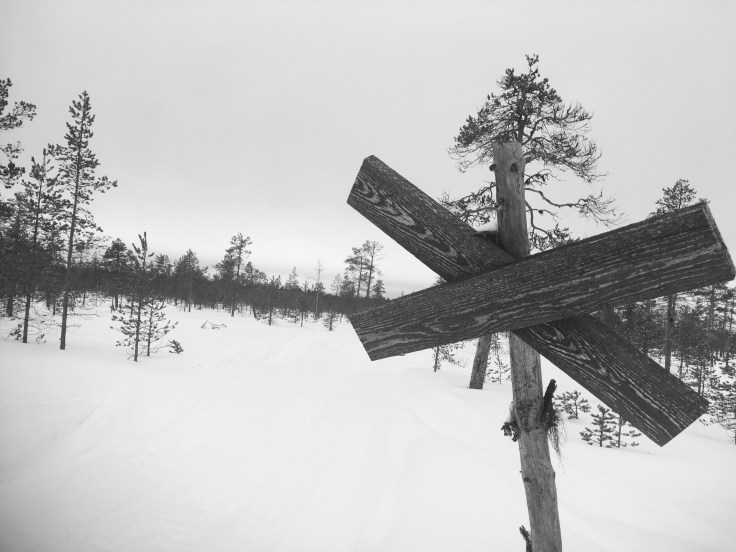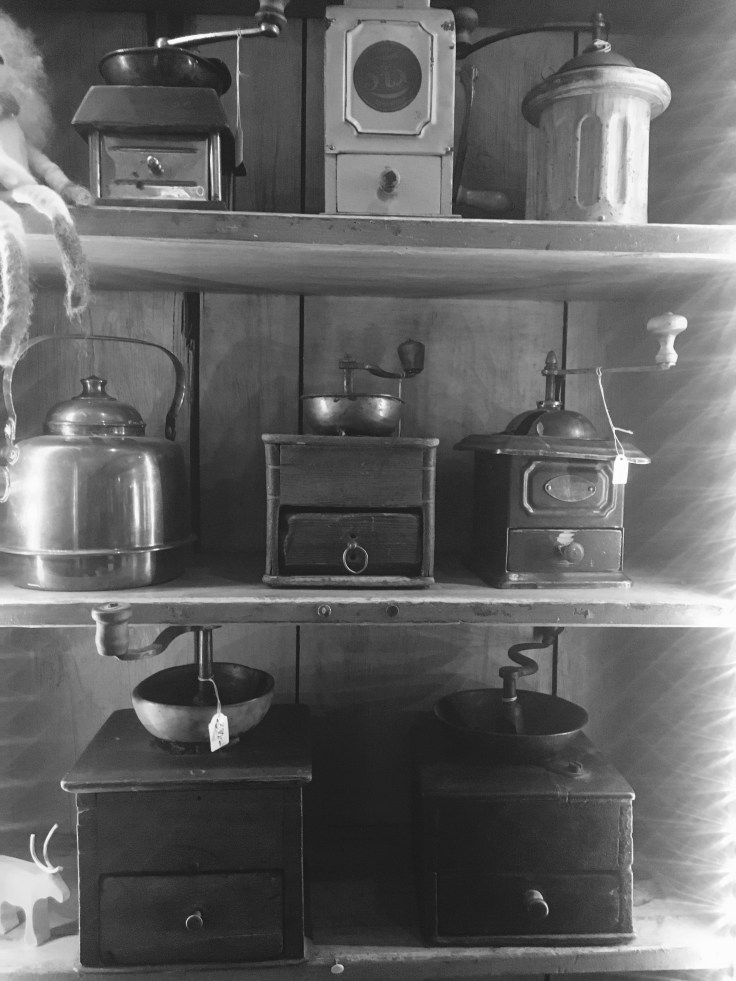Örjan is getting cows
I hear that the farmers of this valley
All the herdsmen are selling out
Moving on from dirt and udders
Grass and hustling dairy
Because the pay’s no living wage
But Örjan, he’s getting cows
When I left Örjan Päjäärvi’s house, I had a few directions to Kjell Kangas’ (pronounced “shell’s”) place in Pajala, just past the bridge by the river, the red house. Kjell is the older brother of Mikael from Junosuando just upriver who I stayed with in the summer. The red house, I thought, he must be mad, we’re in Sweden, nearly every house I’ve seen is red and by the river.
Pajala is a relatively big town with an indoor hockey arena, a theater, two groceries, a great little cafe, and at the center is a sundial built with enormous timbers. On the south end is a big modern looking bridge over the river, and Torne is gridded with snowmobile tracks up and down and across.
As I skied in I saw the tower belonging to the yellow church rising above the trees, and there by the river, the red house in all its glory, Kjell’s place. There are neighbors with red houses, but something about this place was magnetic, and sure enough, it was the home of Kjell and Regina and their two kids, Helmi and Malte. I saw Kjell in the window as I skied up, and he welcomed me in for coffee and to dry my gear.

Kjell works in the school in Pajala as a special teacher in classes that need assistance and he delivers lessons to classes when he gets the chance. We talked a lot about the refugees, and how he tries to help the Swedish students understand where their new classmates are coming from, cities like Aleppo and Mosul, cities that are battlegrounds at this very moment. A long way from Pajala.
Kjell is also on the board of the local hockey association. This work comes after many years of running his own company helping other businesses make promotional material. He is a photographer, and in the house is a nice collection of old cameras and 16mm film projectors.
Regina works at the local theater, which is a community cultural project happening all through Tornedalen. They even do some performances in Mienkieli, and they try to focus on local material, folklore and stories based here to help keep the spirit of this place alive. A writer among other things, Regina just finished a play that will be on stage in April, and rehearsals were just beginning when I was there. Catty corner to Kjell’s camera collection is a nice library of books, many about this place, and I felt so glad to be in the home of people with kindred interests in the arts.
Kjell and Regina’s two kids,Helmi and Malte, were on school break. Helmi is, I think, 9, and though she does not speak a lot of English, we got on well, especially when I became the breakfast chef for a few days. The first night I arrived, Kjell and Helmi went to play ping pong at the recreation hall and the next day we three played a bit of hockey. It was nice to see Kjell being such a good dad. Malte is a classic case of 15. I didn’t see him much except for eating, passing through the kitchen to retrieve food, or when I went to see one of his hockey games. All the same, it was good to hang out with the family and have such a nice welcome into their lives.


It also turns out that Lars Munk and his wife Evelyn are raising their two kids in a house just 100 feet from Kjell’s place, so I got to hang out with them for dinner one night. We had wild Moose stew and potatoes, wine and a bit of whiskey to put us out after a long night of great talk, everything from coffee to global affairs, fish to statistics professors (if you don’t know about Hans Rosling, google him, watch some lectures).
At first I was surprised by how much wild meat I was eating here, but now it is more matter of fact. This region is quite big with few people and lots of wildlife. Eating moose and fish, this is how people can survive with what’s around them, especially considering how farmers all through northern Sweden have been disenfranchised by EU subsidies and agricultural pricing standards.
Evelyn comes from what she called a “trapper family,” and Lars as you know by now is a keen fisherman. Between them, they have so much knowledge about the woods and waters, I think they could survive up here without international trade. The same can’t be said for many people, but there probably more able forest folk in Tornedalen than your average place. Kjell told me he used to go hunting in the morning before school.
There a theme that has come up in many conversations along the journey; how the lives of working people who produce food and essentials could and should be more honored and valued. Shouldn’t the first thing a society values and honors be the growers and the carpenters? The ones who make life possible? If they aren’t the first ones, they might be the last!
Farmers here have had to close up because the economy doesn’t price their goods well enough, it’s not a living wage. With a few exceptions, reindeer herders are the ones working these days, and that’s because Tornedalen is one of the few places in the world reindeer husbandry is legal. Örjan getting cows is really a neat anomaly, and he is the talk of town for it, bringing the food back, closer to home.
So if the milk, meat, and vegetable production are being exported, what jobs does that leave for the working class? Well an iron mine opened up by Kaunisvaara just north of Pajala a few years back promising jobs, and well paying ones, but it closed down because prices were low and iron is cheaper from mines in Brazil. How can Swedish mines compete while there are high taxes, expensive pay for labor and strict regulations for companies? Shouldn’t that be a global norm? What about mining for milk? Prospecting for potatoes?
As I skied away from Pajala I had these thoughts in mind and my eyes on Kangos, a village a ways up the Lainio River, a tributary of Torne that enters from the north. I was going there to meet Johan Stenevad and Eva, a pair that run the Lapland Guesthouse in Kangos. But first I had to cross Teravuoma, the largest bog in Western Europe.

For a skier who’s been chugging through forest and over hills, down gullies and up hillocks, Teravuoma was like a superhighway. Flat as flat can be for 50 kilometers. Bogs don’t really freeze even in Lapland winter, so one has to be careful to avoid holes, but I was on a snowmobile road, so the kilometers melted away over the flat wetland, the sphagnum pancake.

Arriving to Kangos I was impressed at the size of Lainio River, nearly as wide as Torne. I recalled when Kjell told me that he calls Tornedalen Sweden’s largest island because it is surrounded by rivers. Here is Lainio, it flows into Torne soon, which above Junosuando loses 56% of its water to Tarendo River which then flows into Kalix River. Below Pajala, Torne receives Muonio. Just there are five huge rivers all linked through this valley.
After a quick coffee at the Kangas grocery store, I skied up the road to Lapland Guesthouse, a cluster of old homes that were moved to the site by Johan and Eva and restored and decorated to become a cozy getaway by Lainio. Lars wanted me to come and meet Johan and Eva, to see their antiques collection and the knives that Johan makes.

I was greeted by a quiet house. Johan was out and about with some guests and I don’t know where Eva was, but one of the staff, Petter, showed me to my room, the Birch room, themed by the trees. It was a little nook with low ceilings and a view from the window that showed the river and the other houses around. I spent the afternoon by the fire until the other guests, four friendly Belgians arrived with Johan. We got acquainted and Johan entertained all before Eva and Mia, a blacksmith and kitchen staff, brought out dinner–arctic char, green beans, and potatoes. Simple and delicious.
I spoke with Johan for a bit after dinner, and the guy is honest as a lag bolt. He spoke about how he entertains a lot of people with wealth in his business and how it is a lot of work for Eva and him, dawn to dusk everyday, business is life is fun is hard is long is short is vision is life is fun is hard is food is dreams is work is life…. It reminded me of Yellow Birch Farm in Deer Isle Maine where I had the great privilege of spending a few weeks working and playing last summer. Honest work. Work for the mind and body. They don’t make millions, but he is able to build things and dream up new ideas. Now he is going to build a blacksmith shop there where Mia and others can make things.


I am curious, what would happen if every high school student were required to spend two months working on a farm within 100 miles of home? We all eat, why not see how it’s done?
In the morning over breakfast I talked more with the Belgian folks and learned of their lives and work before setting out for Junosuando.
Skiing through the gray and glum
March wind licking at my lashes
I had gratitude in my boots
Thanks in my old mitts
Thanks for working people
Earnest folk
Folk to whom it really makes sense
To give just a dime’s care for cents
A quarter’s care for work
A life’s savings spent
On the dreams that
Soothe the living soul
PS. Few photos in this one because my phone had some serious problems the other day… less is more!!!

great to get this overview of your past week or so!
LikeLike